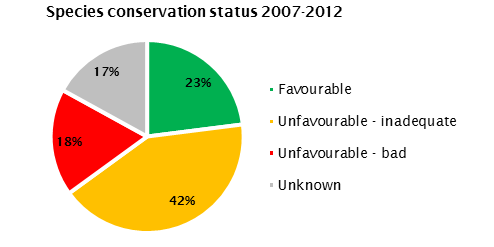Article by Katy Orford, National Assembly for Wales Research Service
The European Commission has published a new State of Nature Report (PDF 432 KB) which it says provides the ‘most comprehensive picture yet’ of the conservation status of species and habitats in the EU. It provides an assessment of the Habitats and Birds Directives based on data from 2007-2012. The report presents a mixed picture on performance, and has drawn strong reactions from environmental NGOs. Background Every six years, Member States must report on the conservation status of species and habitat types protected under the Habitats and Birds Directives. The report covers all wild bird species (about 450), 231 habitat types and more than 1200 other species of EU interest. This State of Nature report is underpinned by the European Environment Agency’s (EEA) technical report, State of Nature in the EU: Results from reporting under the nature directives 2007-2012 which draws on assessments submitted by Member States. The 2015 report is the first assessment to cover both the Birds and Habitats Directives and as such the Commission states that it is the largest collaborative data-collection and assessment of nature undertaken across the Member States. Key findings Birds  The report shows that about a third of bird species (32%) have unfavorable status. It shows that many bird species, e.g. birds of prey and many large carnivores, have shown significant improvements in some areas, but these improvements are currently limited to local or regional level, and have not yet scaled up to European level. Case studies show that:
The report shows that about a third of bird species (32%) have unfavorable status. It shows that many bird species, e.g. birds of prey and many large carnivores, have shown significant improvements in some areas, but these improvements are currently limited to local or regional level, and have not yet scaled up to European level. Case studies show that:
- Once common farmland species such as the Skylark, Alauda arvensis and the Black Tailed Godwit, Limosa limosa are now threatened;
- The Roseate Tern, Sterna dougallii has reached a stable population status after suffering huge declines in the 1970s and 1980s.
Species under the Habitats Directive  The report shows that over half (60%) of species under the Habitats Directive have unfavourable status. Only 16% of the fish species assessed have favourable conservation status, over a quarter of vascular plants (29%) and amphibians (28%) are considered favourable and 21% of mammals. Case studies show that:
The report shows that over half (60%) of species under the Habitats Directive have unfavourable status. Only 16% of the fish species assessed have favourable conservation status, over a quarter of vascular plants (29%) and amphibians (28%) are considered favourable and 21% of mammals. Case studies show that:
- The Otter, Lutra lutra, is showing signs of improvement. In the Atlantic region, it has made a steady recovery over the last 20 years which the report accredits to a decrease in certain waterborne pollutants.
- The Large Copper butterfly, Lyceana dispar, is also improving across the Continental region which the report accredits to targeted conservation measures.
Habitats under the Habitats Directive  The report shows that about three quarters (77%) of habitats under the Habitats Directive have unfavourable status. The main threats to habitats identified were:
The report shows that about three quarters (77%) of habitats under the Habitats Directive have unfavourable status. The main threats to habitats identified were:
- agricultural practices including modification of cultivation practices, over-grazing, abandonment of pastoral systems, fertilisation and pesticides;
- human-induced “modifications of natural conditions” mostly relating to hydrological changes.
The report states that the Natura 2000 network appears to be an effective conservation measure which also benefits non-target species. When looking at the habitats and species with an unfavourable status a positive correlation can be detected between the level of Natura 2000 coverage and conservation status trends. Hans Bruyninckx, EEA Executive Director, commented on the report’s findings:
The results are mixed but clear. When implemented well, conservation measures work and improve the status of habitats and species on the ground. Such improvements remain limited and patchy, and unfortunately Europe’s biodiversity is still being eroded overall and the pressures continue.
Wider implications The State of Nature reports serve as input to the Mid-Term Review of the EU Biodiversity Strategy. The findings will also feed into the ongoing Fitness Check of the Birds and Habitats Directive. Stakeholder responses Friends of the Earth have commented that: The European Commission must abandon plans to weaken its nature directives. This report confirms that European laws play a crucial role in defending our most precious habitats and wildlife, and must be enforced across the EU. Ariel Brunner, Head of Policy at BirdLife Europe, stated: The new report shows that conservation efforts are having an impact but that the overall situation of EU biodiversity is still dire. If we do not deal urgently with some of the major drivers of biodiversity loss, agriculture in particular, we are going to miss the 2020 target, lose precious habitats and species and pay a high price as a society. The Commission have published a brochure with a breakdown of the report’s findings. State of Nature in Wales Natural Resources Wales (NRW) has recently produced a report which sets out current evidence on the state of natural resources in Wales. It highlights that the majority of Special Areas of Conservation (SAC) and Special Protection Area (SPA) habitats in Wales are in unfavourable condition (75%) with the exception of caves (100% in favourable condition). This report is designed to start the discussion and process of how NRW can improve the evidence base to inform the preparation of the State of Natural Resources Report which will be a new duty of NRW under the newly laid Environment (Wales) Bill.






